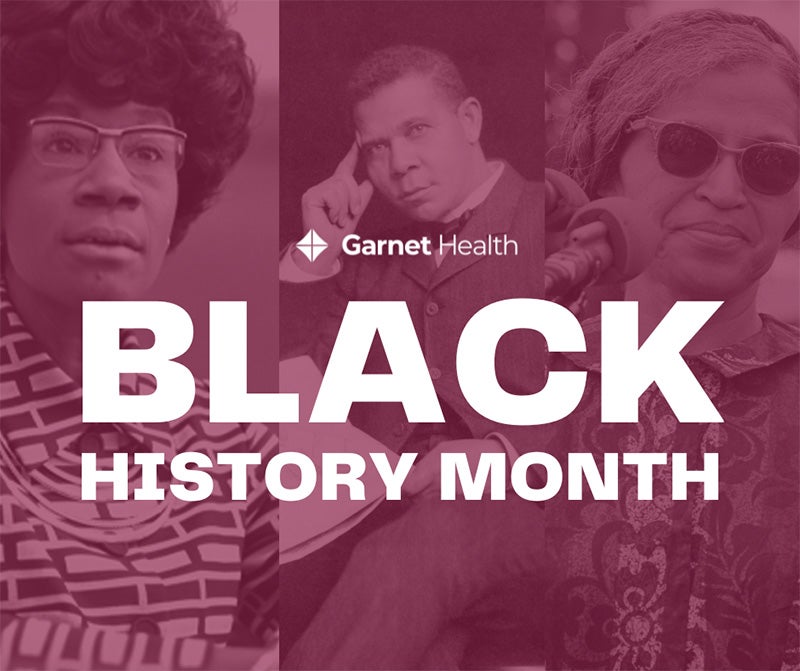Garnet Health joins you in the celebration of Black History Month.
February 1, 2023Categories: Diversity, Equity and Inclusion, Blog
 Black History Month occurs each February and is a time to learn about, reflect and honor the achievements of African Americans and their pivotal role in United States history. Here’s a brief background about the origins of Black History Month and how it came to be celebrated this time of year.
Black History Month occurs each February and is a time to learn about, reflect and honor the achievements of African Americans and their pivotal role in United States history. Here’s a brief background about the origins of Black History Month and how it came to be celebrated this time of year.
How It Started
We must go back to 1926, when Carter G. Woodson, PhD, who cofounded the Association for the Study of African American Life and History (ASALH), first established Negro History Week during the second week of February. Woodson’s intention was to bring the Black experience to America’s attention, using the week to springboard conversations and encourage local schools and communities to organize clubs, performances and other events.
While Negro History Week became recognized throughout the country over the following decades, it wasn’t until the mid- to late-1960s, during the height of the civil rights movement, when college students began demanding courses on African American history as well as the formation of Black Studies Departments at their schools. As a result, Negro History Week evolved into an expanded celebration—Black History Month—on many college campuses. Finally, in 1976, according to History.com, during the bicentennial celebrations, President Gerald Ford officially recognized Black History Month on the national level and urged all Americans to “honor the too-often neglected accomplishments of Black Americans in every area of endeavor throughout our history.”
But Why February?
Woodson chose to celebrate Negro History Week in February to honor and highlight the accomplishments of two important historical figures who have February birthdays.
The first was 16th U.S. president, Abraham Lincoln, who fought to preserve the Union during the U.S. Civil War and was influential in bringing about the emancipation of slaves. The other was Frederick Douglass, a former slave who became a prominent leader in the abolitionist movement, which fought to end slavery.
Honoring Achievements of Black Americans in Healthcare
There are many Black Americans who have greatly impacted and advanced healthcare. Here we highlight just three:
Charles Drew, MD, CM, was considered Father of the Blood Bank and served as its first director. Drew became interested in transfusion medicine during his time in medical school in Montreal, Canada. After winning a fellowship to train at Presbyterian Hospital, he continued his research while also earning his doctorate at Columbia. Drew’s expertise in blood storage and transfusions led to his appointment as head of the Blood for Britain Project during World War II, which pioneered a method that allowed blood to be stored for long periods of time and used in transfusions. This program became the model for the Red Cross Blood Bank, and in 1941, Drew was named its first director. Among the doctor’s innovations at the Red Cross was the bloodmobile—a mobile blood donation truck with refrigerators. Sadly, Drew resigned a year later after the Red Cross announced they would segregate white and black donors.
Henrietta Lacks unknowingly became the source of the first immortalized human cell line in 1951, when cancer cells were biopsied from her during treatment for cervical cancer. These cancer cells were cultured and became known as the HeLa cell line, which is still widely used for medical research. Lacks died in 1951 from cervical cancer, but her HeLa cells continued to be used for research into vaccines, cancer, AIDS, gene mapping and many other areas of medicine. Lacks’ family was not made aware of the HeLa cell line until 1975, and neither Lacks nor her family were compensated for their extraction or use. Their use continues to prompt conversation and controversy about privacy and patients’ rights.
Vivien T. Thomas, LLD, Instructor of Surgery at Johns Hopkins Hospital, developed the surgical procedure to treat what was then called “blue baby syndrome,” now known as cyanotic heart disease. With only a high school education, Thomas first secured a job as a surgical research assistant in 1930. He eventually rose above the challenges of institutional racism and poverty to advance his studies and become a pioneer in cardiac surgery. Thomas was only paid a janitorial salary and was not included in official articles about the procedure he developed. In 1976, Johns Hopkins University finally presented him with an honorary doctorate, and he was appointed to the faculty of the School of Medicine as an instructor of surgery.
Garnet Health’s Commitment to the Community
Garnet Health recognizes that diversity and inclusion are multifaceted issues and that we need to address them holistically to better engage and support all underrepresented groups within our community. To do this, we believe we also need to address honestly and head-on the concerns and needs of our diverse employees and our community, as well as continue to increase equity and inclusion for all.
As we start February—Black History Month—we reaffirm our commitment to diversity, equity and inclusion, and pledge to deliver excellent patient care and create equitable outcomes for our patients, community and employees.
